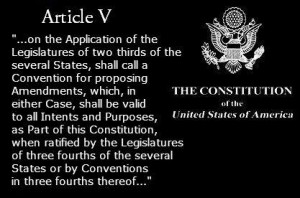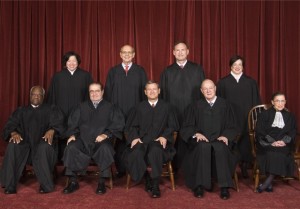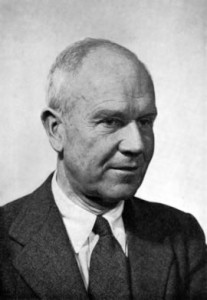Insurrectionary Options: Ballots vs. Bullets
It is time for believers in God and country to get real, and face the fact that the enemy is at the gates and starting to come over the wall. They might not feed us to the lions, but already they’re throwing us to the lawyers. Just ask Baronelle Stutzman, the Christian florist in Tri Cities who was sued in April by the Washington State Attorney General, as well as by the ACLU, because she declined, on religious grounds, to provide flowers for a same sex wedding.
The month of May saw the Boy Scouts bow to corporate pressure and abandon their longstanding “morally straight” pledge. And in June the US Supreme Court entered the fray, siding with forces hell-bent to destroy what remains of Judeo-Christian civilization, and to repudiate the principles of a Republic founded upon “the laws of nature and of nature’s God” (Declaration of Independence).
Assisting same-sex marriage in California, the Court ruled that We the People are very far from the apex, to the extent that ordinary citizens “lack standing” in Court to defend the amendment to the Constitution (California Proposition 8) which they themselves enacted in the first place. In other words – all power to the government, especially to gay Federal Judge, Vaughn Walker of San Francisco, who singlehandedly overturned the State Constitution as amended by seven million citizens at the ballot box.
Even Justice Kennedy could see the flaw. He is no friend to traditional marriage or to Catholic moral doctrine on this issue, but here he dissented:
In the end, what the Court fails to grasp or accept is the basic premise of the initiative process. And it is this. The essence of democracy is that the right to make law rests in the people and flows to the government, not the other way around. Freedom resides first in the people without need of a grant from government. The California initiative process embodies these principles and has done so for over a century.
On the same day the Court overturned DOMA, a Federal law favoring traditional marriage. Justice Alito mockingly paraphrased the Court majority as casting “all those who cling to traditional beliefs about the nature of marriage in the role of bigots or superstitious fools.” With similar sarcasm, Justice Scalia summarized it this way: “only those with hateful hearts,” or “unhinged members of a wild-eyed lynch mob,” could have enacted the Defense of Marriage Act. Driven by such a mindset, the 5-4 Court majority exhibited itself as,
a Supreme Court standing (or rather enthroned) at the apex of government, empowered to decide all constitutional questions, always and everywhere “primary” in its role…. I promise you this (said Scalia): The only thing that will “confine” the Court’s holding is its sense of what it can get away with.[1]
The same could be said for most autocracies and oligarchies. They feel free to go where angels fear to tread, checked only by calculations on how far to go without provoking a revolt.
Until the rise of postmodern politics (pre-1963) the Congress was still a viable check to the Judicial tyranny and to a White House ruling by executive orders. However, our nation’s regular political process, with Congressional elections, etc., was designed for fine-tuning a polity more or less on track, as was the case with the USA into which this writer was born. For basic turnabouts as called for by our radical maladies today, the two houses of Congress resemble the French batteries on the Maginot Line. The artillery was aimed toward Germany and the design prevented the big guns from turning 180 degrees to meet the Nazi blitzkrieg coming from the flank and the rear.
Vesting our hopes for a national turnaround in the off year Congressional elections, or in the next Presidential campaign, is sure to waste still more populist energies, and to dash patriotic hopes. To pursue the course of trying again to win Federal elections, and by such means to deal with the disaster inside the D.C. beltway, is to persist in political insanity. It would qualify as insane by the definition (sometimes attributed to Albert Einstein) of “trying the same thing again and again, and expecting a different result.”
The electoral process in America has been corrupted at the Federal level to the point of being virtually worthless to all but the political class backed by the financial elites. Via highly paid lobbyists, their multinational and foreign owned corporations buy more day-to-day political clout in Washington, D.C. than most U.S. citizens can possibly wield.
For such reasons (and others) the standard paths offer no realistic route to fundamental reform in America. The strategy of circumventing the power structure via extraordinary means offers more promise, like an Article V Convention for proposing Amendments, notwithstanding that this constitutional approach gets reported in the mainstream media as extremist and dangerous.
Indeed, to implement a never used provision in the Constitution is not a little radical. But at least it offers hope at the ballot box, unlike moderate means which have proven incapable of arresting America’s decline. Moderate approaches will never narrow the increasingly radical divergence between God and country.
In terms of genuine political opportunity to change the country’s course, the most promising time may soon be upon us, as the polity, economy and culture begin to disintegrate. National collapse will force citizens to disenthrall themselves, and look to what previously seemed unthinkable.
Such times open up unique windows of opportunity for fundamental transformation, i.e. root reform. The radical problems that afflict postmodern America will require radical solutions, not traditional fine-tuning. In reality, the country’s rapid alienation from God calls for some form of revolution, peaceful or otherwise, to heal the breach.
In the classic revolutions analyzed brilliantly by Harvard Historian, Crane Brinton, [The Anatomy of Revolution, 1938, 1965] the revolutionists had precise, visible targets to oppose, i.e. the royal families and their associated governments. In a democracy, however, any revolution encounters a strong headwind if it focuses on high level elected officials to oppose; for the insurrection may appear to ask the people to dethrone what can, just plausibly, appear to be the officials freely elected by We the People. The Obama/Biden Administration did, according to official election returns, win a 51 percent majority.
But ostensibly democratic regimes are not invulnerable to populist repudiation. The successful insurrection against the Spanish Republic, 1936-39, targeted an elected government that had morphed into an Anarcho-Communist, anti-Christian, and anti-capitalist regime. The resulting armed plebiscite was launched by Catholics defending the Church; they fought under the military command of Gen. Francisco Franco. Warren Carroll, the late Catholic historian, called it The Last Crusade, a book well worth reading. On the battlefield, this counterrevolution was successful in overthrowing the pagan republic of Spain. The victors restored religious freedoms and prerogatives to Christianity, blessings to Spaniards which endured until early in the 21st century.
As for postmodern American “democracy,” an insurrection will stand a far better chance tactically if our campaign proposes a precise objective that trumps the tedious cycles of election outcomes. A higher political standard will give citizens something we can enthusiastically support, namely a constitutional Amendment to reinforce and restore the written U.S. Constitution.
By focusing on fundamental reforms, we will distinguish the revolt from the mere negation of Obama/Biden/Reed, et. al. Such nugatory tactics might oust one plutocratic political machine, only to replace it with another that is little better – or conceivably even worse.
We must embrace counterrevolution, then, not merely for the sake of ousting an oppressive oligarchy. The higher purpose would be restoring the scepter to the written U.S. Constitution, whether by sweeping away the usurpatory regime in Washington D.C.; or alternatively, by seceding from the Union and forming a downsized but upgraded republic coterminous with several of the existing States.
In either case, an Article V convention would have to be a component, playing its constitutional part so that future generations can look back and see the process of reform as conforming to legality; also to the will of the people expressed through balloting for convention delegates. Its overarching aim would be Constitutional restoration, a concept that can easily be made clear to any discerning voter.
Returning the scepter to King Constitution is a simple strategic concept that 4th graders should be able to grasp. And in terms of public relations, one arch-amendment to be firmly planted in the venerable Constitution, and presiding like a banner over the process of fundamental reform, would provide exceptional appeal.
Giving Article V its due
 Counterrevolution against America’s postmodern regime will, to be successful, necessitate not just admirable aims, but also playing out the tactical process of peaceful and legal means. The Framers of the Constitution left us a legal process whereby to outflank a corrupt Federal government, namely to convene a Federal Convention which State legislatures can initiate. The time has arrived for activating this sword of the States. Long has it rested in the scabbard of the Constitution awaiting an era as pervasively decadent and dysfunctional as ours.
Counterrevolution against America’s postmodern regime will, to be successful, necessitate not just admirable aims, but also playing out the tactical process of peaceful and legal means. The Framers of the Constitution left us a legal process whereby to outflank a corrupt Federal government, namely to convene a Federal Convention which State legislatures can initiate. The time has arrived for activating this sword of the States. Long has it rested in the scabbard of the Constitution awaiting an era as pervasively decadent and dysfunctional as ours.
Here is the wherewithal in Thomas Jefferson’s proposed “revolution every 20 years,” famously advocated by the Sage of Monticello, but now long since overdue. Born the same year as Jefferson, Samuel Williams of Vermont (1743-1817), saw the federal constitutional convention as the vehicle for what the 21st century oligarchy likes to call the “living, breathing constitution.”
Congregational minister, Harvard professor, author of the first history of Vermont, and founder of Vermont’s oldest continuously published newspaper; Rev. Williams considered a rigid, unchanging constitution to be high folly, in that “no policy would appear more puerile or contemptible to the people of America, than an attempt to bind posterity to our forms, or to confine them to our degrees of knowledge, and improvement: The aim is altogether the reverse, to make provision for the perpetual improvement and progression of the government itself….” This constitutional flexibility was, wrote Williams, built into Article V by the Framers:
Upon this idea it is one of the essential and constituent parts of American government, that conventions shall be called at certain periods of time, to alter, amend, and improve the present form and constitution of government; as the state, circumstances, and improvements of society, shall then require. Thus provision is made, that the improvement in government, shall keep pace with the improvement of society in America.[2]
Such an amending convention is even more necessary today. It would allow We the People to circumvent the oligarchy/plutocracy that governs inside the D.C. beltway. Thus, our revolution could proceed directly through State legislatures.
This amending process is designated in the 5th Article of the Constitution itself. Its neglect is one of the great omissions of American history. As distinguished from the “living, breathing” process of revision by usurpation, practiced so routinely now via a dictatorship of judges; the convention procedure would have in former eras, and would in our own time, re-empower the people to govern democratically within the framework of a revitalized Republic.
As to the near future, the peaceful/legal means bequeathed to us by the Framers of Article V will be ignored at our peril, insofar as exhausting all available means is obligatory before we can solicit the interposition of divine Providence on behalf of anything resembling the efforts of our ancestors in the continental army. Armed revolution is illicit, and cannot merit God’s blessing, until preconditions are met (Catechism of the Catholic Church, 2243). The principle of exhausting alternative means is enshrined also in The Declaration of Independence:
In every stage of these Oppressions We have Petitioned for Redress in the most humble terms: Our repeated Petitions have been answered only by repeated injury.
Yet another of the catechetical conditions is that “there is certain, grave, and prolonged violation of fundamental rights.” To be sure this condition has existed for a prolonged period of time in the United States. If the regime adds a new grievance to the list, namely blocking us from exercising the Article V convention option, to which we have a constitutional right; then we could undertake armed insurrection in good conscience. Armed revolution is justifiable only in extremis, after the regime is put clearly in the wrong.
Another of the catechetical conditions is that there be “well-founded hope of success.” Such a hope will certainly be enhanced to the extent that we take the moral high ground at the outset, and maneuver the regime into taking the low ground by being the first to use the sword.
Hopefully the extremity – recourse to the sword – can be preempted by peaceful means. But as President John F. Kennedy put it in 1962: “Those who make peaceful revolution impossible will make violent revolution inevitable.”[3]
Endnotes
[1] United States v. Windsor, Justice Scalia dissenting, joined by Justice Clarence Thomas and in part by Chief Justice John Roberts.
[2] Samuel Williams, The Natural and Civil History of Vermont, 2 vols. (Burlington VT, Samuel Mills, 1809) 2:395-96.
[3] John F. Kennedy’s Address on the First Anniversary of the Alliance for Progress, White House reception for diplomatic corps of the Latin American republics, March 13, 1962. Public Papers of the Presidents – John F. Kennedy (1962), p. 223.






